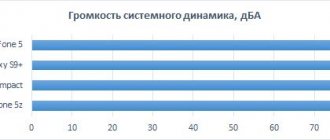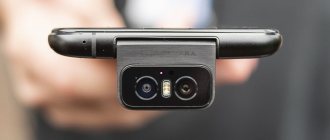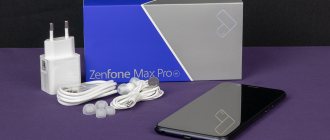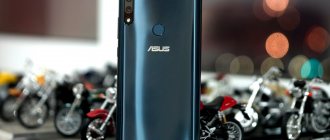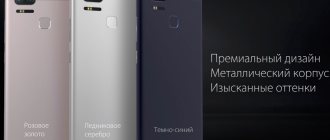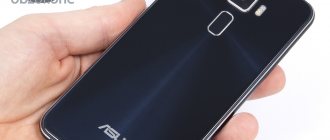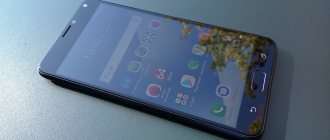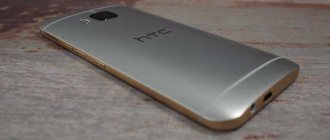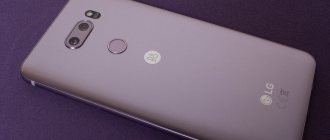We paid attention to the Zenfone line of smartphones from ASUS last year. We got acquainted with almost all the gadgets included in this series - Zenfone 4, Zenfone 5 and Zenfone 6. They turned out to be quite different, each with its own set of advantages and disadvantages, but they had one thing in common - in terms of functionality and capabilities, each of the Zenfone "could compete with more expensive devices. Among its classmates, Zenfone 5 at the time of its release was one of the most productive and technically equipped devices. It was mainly the nameless “Chinese” that competed with it - other gadgets with a similar set of characteristics turned out to be more expensive.
First-tier manufacturers, unfortunately, rarely make offers like Zenfone. Typically, the policy of A-brands is as follows: if you want a fast gadget, pay twice as much. "Zenfon" is a kind of exception that confirms the rule. Even the official press release says the following (we quote): “ASUS believes that the unique advantage of ZenFone 2 is its price. This smartphone has many features that are usually found only in models that cost almost twice as much.” In general, this is how it really is.
The new device in the series, Zenfone 2, which will be discussed below, is significantly more expensive than previous gadgets in this line. They ask for an average of twenty thousand rubles. The reasons for this are obvious: in terms of technical characteristics, the device can compete with current flagship devices from many manufacturers, and the ruble is no longer what it was at the time of the launch of the first generation Zenfone. After all, how many middle-end smartphones do you know with four gigabytes of RAM on board? The rest of the Zenfone 2's specifications are also impressive - they are significantly better than any of the previously released devices in the series.
⇡#Technical characteristics
| ASUS Zenfone 2 (ZE551ML) | ASUS Zenfone 2 (ZE550ML) | ASUS Zenfone 5 (A500KL) | ASUS Zenfone 6 (A600CG) | |
| Touch screen | 5.5 inches, 1080 × 1920 pixels, IPS; Capacitive, up to 10 simultaneous touches | 5.5 inches, 720 × 1280 pixels, IPS; Capacitive, up to 10 simultaneous touches | 5 inches, 720 × 1280 pixels, IPS; Capacitive, up to 10 simultaneous touches | 6 inches, 720 × 1280 pixels, IPS; Capacitive, up to 10 simultaneous touches |
| Air gap | No | No | No | No |
| Protective glass | Corning Gorilla Glass 3, with oleophobic coating and polarizing filter | Corning Gorilla Glass 3, with oleophobic coating and polarizing filter | Corning Gorilla Glass 3, with oleophobic coating and polarizing filter | Corning Gorilla Glass 3, with oleophobic coating and polarizing filter |
| CPU | Intel Atom Z3580: Quad core Tangier architecture (x86-64), Frequency 2.33 GHz; 22 nm process technology | Intel Atom Z3560: Quad core Tangier architecture (x86-64), Frequency 1.83 GHz; 22 nm process technology | Intel Atom Z2560: Two cores of Saltwell architecture (x86), Frequency 1.6 GHz; process technology 32 nm HKMG | Intel Atom Z2580: Two cores of Saltwell architecture (x86), Frequency 2.0 GHz; process technology 32 nm HKMG |
| Graphics controller | Imagination Technologies PowerVR Rogue G6430, 533 MHz | Imagination Technologies PowerVR Rogue G6430, 533 MHz | Imagination Technologies PowerVR SGX544MP2, 400 MHz | Imagination Technologies PowerVR SGX544MP2, 533 MHz |
| RAM | 4 GB LPDDR3 | 2 GB LPDDR3 | 2 GB LPDDR2 | 2 GB LPDDR2 |
| Flash memory | 32 GB (approx. 25.5 GB available) + MicroSD + 5 GB ASUS WebStorage cloud storage | 16 GB (approx. 11.5 GB available) + MicroSD + 5 GB ASUS WebStorage cloud storage | 16 GB (approx. 12 GB available) + MicroSD + 5 GB ASUS WebStorage cloud storage | 16 GB (approx. 12 GB available) + MicroSD + 5 GB ASUS WebStorage cloud storage |
| Connectors | 1 × micro-USB 2.0 1 × 3.5 mm headset jack 1 × microSD (SDHC/SDXC) 2 × micro-SIM | 1 x micro-USB 2.0 1 × 3.5 mm headset jack 1 × microSD (SDHC/SDXC) 2 × micro-SIM | 1 x micro-USB 2.0 1 × 3.5 mm headset jack 1 × microSD (SDHC/SDXC) 2 × micro-SIM | 1 x micro-USB 2.0 1 × 3.5 mm headset jack 1 × microSD (SDHC/SDXC) 2 × micro-SIM |
| cellular | 2G/3G/4G 2G: GSM/GPRS/EDGE 850/900/1800/1900 MHz 3G: DC-HSPA (42 Mbps) 850/900/1900/2100 MHz LTE Cat. 4 (150 Mbit/s, 50 Mbit/s); FDD LTE : 1/2/3/4/5/7/8/9/17/18/19/20/28/29 TDD LTE : 38/39/40/41 Two micro-SIM cards | 2G/3G/4G 2G: GSM/GPRS/EDGE 850/900/1800/1900 MHz 3G: DC-HSPA (42 Mbps) 850/900/1900/2100 MHz LTE Cat. 4 (150 Mbit/s, 50 Mbit/s); FDD LTE : 1/2/3/4/5/7/8/20 TDD LTE : 38/39/40/41 Two SIM cards micro-SIM format | 2G/3G 2G: GSM/GPRS/EDGE 850/900/1800/1900 MHz 3G: DC-HSPA (42 Mbps) 850/900/1900/2100 MHz 4G: not supported Dual micro-SIM cards | 2G/3G 2G: GSM/GPRS/EDGE 850/900/1800/1900 MHz 3G: DC-HSPA (42 Mbps) 850/900/1900/2100 MHz 4G: not supported Dual micro-SIM cards |
| WiFi | 802.11a/b/g/n/ac + Wi-Fi Direct | 802.11a/b/g/n/ac + Wi-Fi Direct | 802.11b/g/n + Wi-Fi Direct | 802.11b/g/n + Wi-Fi Direct |
| Bluetooth | 4.0 | 4.0 | 4.0 | 4.0 |
| NFC | Eat | Eat | No | No |
| IR port | No | No | No | No |
| Navigation | GPS, A-GPS, GLONASS | GPS, A-GPS, GLONASS | GPS, A-GPS, GLONASS | GPS, A-GPS, GLONASS |
| Sensors | Illumination, proximity, accelerometer/gyroscope, magnetometer (digital compass) | Illumination, proximity, accelerometer/gyroscope, magnetometer (digital compass) | Illumination, proximity, accelerometer/gyroscope, magnetometer (digital compass) | Illumination, proximity, accelerometer/gyroscope, magnetometer (digital compass) |
| Main camera | 12.6 MP (4096 × 3072), PixelMaster technology, f/2.0 aperture, Autofocus, LED flash | 12.6 MP (4096 × 3072), PixelMaster technology, f/2.0 aperture, Autofocus, LED flash | 8 MP (3264 × 2448), PixelMaster technology, f/2.0 aperture, Autofocus, LED flash | 12.6 MP (4096 × 3072), PixelMaster technology, f/2.0 aperture, Autofocus, LED flash |
| Front-camera | 4.9 MP (2560 × 1920), No autofocus, no flash | 4.9 MP (2560 × 1920), No autofocus, no flash | 2 MP (1600 × 1200), No autofocus, no flash | 2 MP (1600 × 1200), No autofocus, no flash |
| Nutrition | Non-removable battery: 11.4 Wh (3000 mAh, 3.8 V) | Non-removable battery: 11.4 Wh (3000 mAh, 3.8 V) | Non-removable battery: 8 Wh (2110 mAh, 3.8 V) | Non-removable battery: 12.5 Wh (3300 mAh, 3.8 V) |
| Size | 152 × 77 mm Case thickness 10.9 mm | 152 × 77 mm Case thickness 10.9 mm | 148 × 73 mm case thickness 10.3 mm | 167 × 85 mm case thickness 9.9 mm |
| Weight | 170 g | 170 g | 145 g | 196 g |
| Water and dust protection | No | No | No | No |
| operating system | Android 5.0 Lollipop ASUS ZenUI shell | Android 5.0 Lollipop ASUS ZenUI shell | Android 4.3 Jelly Bean ASUS ZenUI shell | Android 4.3 Jelly Bean ASUS ZenUI shell |
| Current price | 19,990 rubles | 15,990 rubles | 5,990 rubles | 10,990 rubles |
Potential buyers of ASUS Zenfone 2 should take into account that in nature there are two versions of this smartphone. Only one is intended for official sale in Russia - with the internal index ZE551ML. This is exactly what we tested. In addition to it, there is also a more modest modification of the ZE550ML - it has a lower resolution screen, a slightly worse platform, and less built-in flash memory and RAM. It costs, of course, also less money. In theory, you and I shouldn’t know about it - it doesn’t seem to concern us in any way, but in practice it is actively sold in Russian online stores. So when buying Zenfone 2, check the internal index of the device you are purchasing so that you don’t accidentally buy the wrong thing.
| ASUS Zenfone 2 (ZE551ML) – information about the system and hardware according to the CPU-Z application | ||
Review of the ASUS ZenFone 2 (ZE551ML) Android smartphone: the flagship of the ZenFone line
Table of contents
- Introduction
- Specifications
- Packaging and equipment
- Appearance and design
- Display
- Hardware platform and performance
- Firmware and software
- Multimedia
- Memory and file system
- Wireless Interfaces and Communications
- Navigation
- Battery life
- Camera
- Accessories and Accessories
- Comparison with competitors
- Conclusion
Introduction
ASUS (ASUSTek) has long been known as a manufacturer of a wide variety of computer equipment.
Among other things, it produces mobile devices, dating back to the times when they were called “palm-held computers” (PDAs). It is logical that the next step was the release of smartphones and tablets. Recently, ASUS has been relying on Intel processors in its devices, which causes a wave of various emotions, both among fans and opponents of this manufacturer. However, the ZenFone line is worth a look.
So, meet the ASUS ZenFone 2 smartphone. In fact, the name “ZenFone 2” hides a whole series of four devices (models from the younger ZE550CL to the older ZE551ML; the latter is available in two versions). This line is a continuation of the previous ZenFone, which turned out to be very successful. But time passes, and representatives of the “old” ZenFone series are slowly losing ground. This is when new items arrived.
The main differences between the ZenFone 2 models are shown in the following image:
announcements and advertising
2080 Super Gigabyte Gaming OC for 60 rubles.
Compeo.ru - the right comp store without any tricks
RTX 2060 becomes cheaper before the arrival of 3xxx
Ryzen 4000
series included in computers already in Citylink
The price of MSI RTX 2070 has collapsed after the announcement of RTX 3xxx
Core i9 10 series is half the price of the same 9 series
The price of memory has been halved in Regard - it’s more expensive everywhere
We received the oldest version of ZenFone 2 for testing – ZE551ML. It is the flagship in this series, and official deliveries of ZenFone 2 to Russia will begin with it.
Specifications ASUS ZenFone 2 (ZE551ML)
| Device type | Smartphone |
| Model | ASUS ZenFone 2 (ZE551ML) |
| CPU | Intel Z3580, 64 bit, 4 cores x 2.3 GHz |
| Video processor | PowerVR G6430 |
| operating system | Android 5.0 |
| RAM | 4 GB |
| Flash memory | 32 GB |
| Screen (size, type, resolution) | 5.5″, IPS, 1920 x 1080 (FHD), OGS |
| Cameras | Main 13.0 megapixel (autofocus, flash); front 5.0 megapixel |
| Number of SIM cards | 2 (micro SIM) |
| MicroSD card support | Eat |
| Data transfer | GPRS, EDGE, 3G, HSPA+, 4G, Wi-Fi 802.11b/g/n/ac, Bluetooth 4.0, NFC |
| Navigation | GPS/A-GPS, GLONASS, BDS (Beidou) |
| Interfaces | USB-OTG, 3.5 mm jack (headphones/headset) |
| Additionally | FM radio |
| Battery | 3,000 mAh (non-removable) |
| Dimensions | 77.2 x 152.5 x 10.9 mm |
| Weight | 170 g |
| Recommended price, rub. | 19 990 |
The review hero is available in different colors. We received a device for testing in a strict black and gray design, in the style of German technical classics.
The smartphone is equipped with a vibration motor, an automatic brightness adjustment sensor, orientation sensors (G-sensor), proximity sensors, a magnetometer, a gyroscope and some other little things. A notification LED is also installed - a very simple but convenient thing. All the hardware runs on Android 5.0 Lollipop OS with ASUS' own ZenUI shell.
The actual weight of the device is almost exactly the same as stated: 176 g (including SIM cards and memory card).
Packaging and equipment ASUS ZenFone 2 (ZE551ML)
It is difficult to make the packaging of a smartphone original and memorable, but ASUS has tried to distinguish itself from other manufacturers here too. The box in which the device is packaged is made in the form of two parts, one of which telescopically extends from the other; while the outer part is made with an inclined bevel:
And if you look from the reverse angle, you will notice round holes, through which you can see the symbols printed on the inner half of the package:
The name of a specific model, by which the degree of advancedness of the device is determined, is indicated on the bottom side of the package:
Technical data is also provided here; however, in a very abbreviated form.
Now we pull out the inner box and see what’s inside:
There we can see the smartphone itself, on which a transport protective film with some technical information, mainly of an advertising nature, is pasted. All accessories are located in the lower compartment of the box.
Let’s take a closer look at the device with the “advertising” protective film:
Noteworthy is the text in English: “5.5 inch Full HD IPS display in a 5-inch body” (“5.5-inch Full HD display in a 5-inch body”). By this, the manufacturer hints that the frames around the display are very narrow. And they are really narrow; but they cannot be called record-breaking, since both frameless smartphones and smartphones with curved display edges have already appeared.
Now let's examine the equipment of the device. In the following photo you can see a standard USB-microUSB cable, headset and power supply (“charging”):
The cable and headset are not of particular interest, but the power supply is very interesting, since it is made with support for “fast charging” technology (for more details, see the chapter “Battery life”).
Let's take a closer look at the side of the charger, where its technical characteristics are laser engraved:
According to the technical specifications, this “charging” can produce two output voltages: 5 V and 9 V (both at a current of 2 A). This feature is necessary to implement the “fast charging” technology used in the smartphone. With other chargers, our device will charge in the “ordinary” way.
Traditionally, the device comes with a user manual and a warranty card. The latter is too trivial, and the cover of the manual is shown in the photo below:
When viewed at 100% scale, you can see it in expanded form.
Let's summarize the simple, frankly speaking, equipment of the gadget:
- The smartphone itself;
- Charger;
- USB-micro – USB cable;
- Headset;
- User guide;
- Warranty card.
Unfortunately, there is no cover or case to protect the smartphone from accidental damage, nor is there a USB-OTG adapter for connecting external devices. The cover is offered by the manufacturer, but it is not included in the kit, and you have to buy it for extra money.
Well, the delivery package provides the standard minimum: everything you need is there, but there are no additional frills or bonuses.
⇡#Options
ASUS Zenfone 2 – factory box
The device comes in a rather heavy and voluminous box made of thick cardboard. Inside it, in addition to the gadget itself, we found the following accessories:
- charger with USB connector 2 A;
- USB ↔ micro-USB cable;
- in-ear headphones with three sets of silicone tips;
- printed user manual.
ASUS Zenfone 2 – delivery kit
Frequently asked questions about Asus Zenfone 2 4/64Gb
- Is there NFC? Asus Zenfone 2 does not have NFC support.
- Is there fast charging? Yes. There is support for fast charging.
- Is there an IR port? The Asus Zenfone 2 doesn't have an infrared port, so you can't use it as a remote control.
- Can I insert a memory card? You can insert a microSD memory card into the Asus Zenfone 2.
- Which headphone jack? The Asus Zenfone 2 has a standard 3.5mm headphone jack. No adapter needed.
- Is there 5g? Asus Zenfone 2 does not have 5G support.
⇡#Appearance and ergonomics
Let's start with the obvious: Zenfone 2 is a fairly large smartphone, with a large 5.5-inch display. Usually they somehow play up the large screen - reduce the thickness of the side frames around it, move the navigation keys to the display. ASUS engineers decided not to do any of this.
ASUS Zenfone 2 – front panel
The thickness of the side frames around the screen of Zenfone 2 is approximately four millimeters on each side, which is quite a lot by modern standards. At the bottom of the front panel there are touch-sensitive hardware keys “Back”, “Home” and “Menu”, and below them there is a decorative insert that increases the already large dimensions of the gadget.
ASUS Zenfone 2 – hardware keys under the screen
For those not used to devices of this caliber, using the Zenfone 2 with one hand can be a bit awkward. To reach the far corners of the display, you have to place the gadget in your palms. The device weighs 170 grams - if you hold it suspended for a long time, your hand may get tired. The thickness of the case varies from 4 mm at the thinnest part to 10.9 mm – taking into account the protruding rim of the rear camera.
ASUS Zenfone 2 with screen on
At the top of the front panel there is a front five-megapixel camera lens, an LED indicator, a speaker mesh and an optocoupler of light sensors. The front panel is covered with a sheet of tempered glass Corning Gorilla Glass 3, which quite successfully protects the display from scratches and other damage.
ASUS Zenfone 2 with screen on
The arrangement of the hardware keys on the gadget is not entirely standard. The device's power/lock button is located on the top end, where there is also a universal 3.5 mm audio jack for connecting a wired headset. Due to the large dimensions of the case, it is not very convenient to reach it with your index finger. It is much easier to unlock the device by double “tapping” on the screen - the device has an analogue of the Knock On option from LG.
The micro-USB 2.0 interface is located at the bottom end. The side edges of the body are empty.
| ASUS Zenfone 2 – side ends | ||
The question arises: how can the volume be adjusted? In Zenfone 2, the volume control buttons are placed on the rear panel - this is another reference to LG gadgets, where this solution has been used for the second year. During everyday use, the buttons do not interfere: there are no erroneous touches when the device is in your hands or in your pocket. Next to the volume control keys is the main 12.6-megapixel camera lens and a dual-LED flash. At the bottom of the “back” there is an external speaker.
ASUS Zenfone 2 – rear panel
The back cover of the device is removable. Under it there are slots for two micro-SIM cards and a slot for installing a MicroSD flash drive. There is no access to the battery - if necessary, you will have to contact a service center to replace it.
ASUS Zenfone 2 without back cover
The gadget is well assembled: the device firmly withstands the twisting and breaking test - no colored streaks appear on the screen, there are no suspicious backlashes or creaks. Obviously, there are enough stiffeners in the structure. The body of the device is plastic. ASUS Zenfone 2 comes in five different colors - Osmium Black, Sheer Gold, Glacier Gray, Glamor Red and Ceramic White. A gray version of the smartphone came to us for testing. She looks very strict, discreet, but quite interesting. Judging by the photographs, the devices differ only in the color of the rear panel. So, when the gadget gets boring, you can purchase a replacement “back” of a different color and refresh its appearance.
ASUS Zenfone 2 – available colors
⇡#Display
The smartphone has a 5.5-inch screen with Full HD resolution. Its pixel density is high - more than four hundred dots per inch. Individual dots on the Zenfone 2 display are not visible, even if you bring the gadget close to your eyes - the “pixelation” effect is completely absent. Fonts, even the smallest ones, look sharp, so reading electronic documents from the device’s screen is very convenient. Multimedia content looks very detailed - the display resolution is exhaustive for this diagonal. Any more is unnecessary and battery-wasting excess.
The device uses an IPS (in-plane switching) matrix. The picture on it remains contrasty and rich, even when viewed from a large angle. On the Zenfone 2 screen you can quite comfortably watch movies and photos together. The gadget is very responsive. It responds very accurately and quickly to touches - the percentage of erroneous presses during testing was minimal. In total, the device supports up to ten simultaneous touches. The smartphone can be used with loose gloves.
ASUS Zenfone 2 – AnTuTu MultiTouch Test results
The display is made with high quality. The device can be used in bright light because it has a polarizing filter that effectively combats unwanted reflections. There is no air gap between the matrix and the front panel, which also reduces the intensity of unwanted glare. The protective glass here has an oleophobic coating - it does not get dirty as quickly as glass without it. Getting rid of “fingers” and other dirt is not difficult - you can do this with any cloth that is at hand.
The display's brightness reserve is moderate. The maximum luminosity of the white field is 356 cd/m2, the minimum is 14 cd/m2. Such a wide range of illumination allows you to comfortably use the device both in complete darkness and in direct sunlight. However, in the latter case you have to turn the display brightness slider to maximum - otherwise the screen fades. You can also leave this to automation: the gadget has a light sensor, so it can adjust the screen backlight level depending on the surrounding conditions on its own, and it copes with this task very well - adjusting the brightness is quite adequate to the light level and it happens quite smoothly.
The luminosity of the black field at the maximum backlight level is acceptable - 0.42 cd/m2. As the brightness increases, the black color only loses a little depth and becomes a dark, dark gray. The contrast of the display is not outstanding, but quite good – 848:1.
ASUS Zenfone 2 – Grayscale Color Temperature
The color temperature of grayscale, measured on ten shades, averaged 7500 K. The result is not very good - the deviation from the reference value of 6500 K is not critical, of course, but quite noticeable and noticeable to the naked eye. The picture on the Zenfone 2 display looks “cold”.
| ASUS Zenfone 2 – display parameters | ||||
You can adjust the white balance in the settings menu - the user can make the picture warmer or cooler as desired. The device also provides several color profiles: “balanced” – this is also the main one, it was in which we tested the screen, “reading”, “bright” and “custom”. In the “reading” mode, the colors become calmer and muted so that the eyes do not hurt from long-term interaction with the display. The “bright” mode, strangely enough, practically does not increase the level of the display backlight, but makes the colors more saturated, “cartoonish”, like on AMOLED screens. In custom mode, the user can shift the color gamut and adjust the level of color saturation.
| ASUS Zenfone 2 – gamma curves of gray and color components | ||
The screen is not set up very well. All gamma curves – both color components and gray – are noticeably raised along their entire length. This means that the shades of primary colors on the Zenfone 2 display look lighter than they should, resulting in the picture being a little overexposed. It must be admitted that the deviation is not critical - to the eye, the color rendition of the Zenfone 2 screen seems correct.
ASUS Zenfone 2 – smartphone screen color gamut (white triangle) compared to sRGB color space (black triangle)
The color gamut of the smartphone screen is slightly shifted relative to the reference sRGB color space. Having studied the graph, we can conclude that the blue on the Zenfone 2 screen should look a little richer than it should; red, on the contrary, is a little dimmer, and green tends a little towards yellow. However, all this is again at the level of theory and nitpicking: the color gamut, firstly, is very wide, and secondly, not so far from the sRGB framework. In reality, the picture on the Zenfone 2 display looks quite believable, if you don’t pay attention to the “cold” touch.
⇡#Hardware and performance
The older modification of ASUS Zenfone 2 - ZE551ML - turned out to be very interesting in terms of technical characteristics. It has an Intel Atom Z3580 system-on-chip from the current Merrifield family. It appeared on the market in the second half of 2014; Zenfone 2 is the first device in our test lab that runs on this platform. The Atom Z3580 includes four Tangier architecture cores operating at a frequency of 2.33 GHz. The platform is made using a completely modern (although not the most modern that Intel has at its disposal) 22-nanometer technological process using Tri-Gate transistors. Features of this system-on-chip include an expanded second-level cache of 2 MB, out-of-order execution of instructions and support for 64-bit computing.
Judging by the benchmark results, Intel finally has a platform that can compete with Qualcomm and Samsung platforms without any discounts or concessions. In the general synthetic AnTuTu test, the device scored more than 46 thousand points - a very good result! This is approximately twice as much as Zenfone 5 showed, running on the previous generation Intel Atom platform – Z2560.
Another interesting feature of the Zenfone 2 ZE551ML is that it is the first mass-produced smartphone to come with four gigabytes of RAM. DDR3-1600 modules are used. The advantages of a large amount of RAM are obvious: the user can keep more applications, browser tabs and programs open - you can return to them without loading data from a flash drive. Thanks to the successful combination of a fairly powerful platform, a large amount of RAM and well-debugged firmware, the device works very smoothly and does not slow down at all. The system animation is displayed smoothly, there is not even a hint of image twitching.
The volume of built-in flash memory is 32 GB, of which approximately 25.5 GB is available to the user. If necessary, Zenfone 2 can install a microSD memory card with a capacity of up to 64 GB.
The role of the graphics controller in the device is played by the Imagination Technologies PowerVR Rogue G6430 chip, operating at a frequency of 533 MHz. At this frequency it produces 136 gigaflops, which is very good by the standards of mobile GPUs. The chip consists of four clusters with two texture units. The manufacturer claims that it is approximately twice as powerful as the previous solution – PowerVR SGX543MP3. The controller supports OpenGL 3.x/4.x and OpenGL ES 3.0.
In practice, we have confirmed the thesis that the Intel Atom Z3580 is a powerful system-on-a-chip. It easily plays video in the screen's native Full HD resolution and handles resource-intensive toys without any problems. What can we say about multimedia tasks and web surfing - in principle, she cannot have problems with this. Zenfone 2 is suitable for solving most tasks that can be assigned to a smartphone.
⇡#Communication
Another advantage of ASUS Zenfone 2 is its support for working with two SIM cards, which is implemented using the Dual SIM Dual Active scheme. This means that two transceivers are installed in the device, that is, if there is activity on one SIM card, the second one does not go offline. Note that only one SIM card is capable of working in 3G and 4G networks, the second is content with 2G. Working with two SIMs is implemented in a standard way: after installing the cards in the slots, the user determines which of them to call, go online and send SMS/MMS. The call and message log shows which SIM was active. In general, everything is very simple - it is absolutely impossible to get confused in the cards.
| ASUS Zenfone 2 – AndroiTS GPS Test results | ||
The Zenfone 2 has a standard set of wireless interfaces – Wi-Fi, Bluetooth, NFC. There is no IR port for controlling household appliances, but it is not necessary to have one in a device of this class. “Zenfon” navigates the terrain using a navigation module that supports work with GPS, GLONASS and BeiDou satellites, and it does this, I must say, quite quickly. In the open air, the gadget detected a total of twenty-one satellites in half a minute. The navigation error radius was moderate - around twenty meters. The device copes well with the role of a car navigator - although it does not navigate the terrain very accurately, it is very fast.
⇡#Camera
The device has two cameras: front, five megapixel and main, with a 12.6 megapixel sensor. The latter is equipped with an automatic focusing system and a dual LED flash, while the front camera does without autofocus. Using the front camera, you can take good self-portraits and talk to video even in a dark room. Of course, if shooting conditions deteriorate, the picture becomes covered with a generous layer of noise and other artifacts, but it remains quite readable. There’s definitely no shame in uploading photos from the front camera of Zenfone 2 to social networks – the quality of the pictures is very decent.
ASUS Zenfone 2 – main camera
As is usually the case with ASUS gadgets, the Zenfone 2 camera app provides a large number of shooting modes. The device has a “manual” mode, HDR, automatic enhancement of portraits, software sharpening, low light mode, shooting at night, depth of field control mode, a number of visual effects, a mode for taking “selfies” with the main camera, shooting panoramas, shooting animated photos and a number of other interesting options. In general, there is a lot here.
ASUS Zenfone 2 – main camera
The main camera of Zenfone 2 takes very good pictures. Photos taken in good lighting have good sharpness, decent contrast, and high dynamic range. The camera's color rendition is quite natural; the colors are saturated. Indoors, the contrast drops slightly, but the pictures remain quite juicy. To put it mildly, all mobile devices do not cope very well with shooting in the dark. Zenfone 2 has a whole bunch of software options so you can show your friends photos in the dark. This does not completely correct the situation - pictures taken in the dark leave much to be desired: they are quite noisy and blurry, but at least something can be distinguished in them. In general, the main camera of ASUS Zenfone 2 is certainly no worse than other 13-megapixel mobile cameras. This is quite enough.
ASUS_Zenphone_2
View all images (6)
Camera
I'll start with a small drawback - the camera is not recessed into the body at all, you have to be careful not to scratch the lens. Overall, for its price, we have a very good option for photo lovers. With a maximum resolution of 13 MP, photos are obtained with the correct aspect ratio - 4:3. The photo quality during the day is more than acceptable. I had fun taking photos with the ZenFone 2 in Paris for my personal photo collection. The camera has many settings and modes; it’s nice that the most useful ones offer themselves at the right time. For example, if there is strong backlight, the camera will prompt you to turn on HDR. He, by the way, is very Orthodox, as he takes up to 5 photographs at different exposures and glues them into one photograph.
Examples without and with HDR
At the presentation they emphasized the night mode - they say that there is no equal to Zenfon. Be that as it may, you won’t be able to get a beautiful photo, there will be a lot of noise, but indeed, where others just show a black screen, there is something here. Maybe someone will find this functionality useful.
Examples of photos from the main camera
Examples of photos from the front camera
Example video in 1080p
Example video in 720p with stabilization
⇡#Autonomous work
The smartphone is equipped with a non-removable battery of 11.4 Wh (3000 mAh, 3.8 V) - the capacity is quite sufficient for a device of this class. The battery is enough for a working day and even for a day of battery life. During testing, “suddenly” the device did not discharge - it always reached home, although it was used as the main means of communication, navigation, and so on. The usage scenario was approximately as follows: two hours in navigator mode, about an hour of voice calls, 10-15 SMS/MMS and about three hours of mobile and Wi-Fi Internet. The brightness is automatic, with adjustment down two points. By the end of the day, the Zenfone 2 consistently had 20-25% battery left.
In continuous video playback mode at maximum screen brightness, with an active Wi-Fi connection and data updating in the background, the device lasted just over six hours. The result is very good. Of course, if you lower the display backlight level and disable unused wireless interfaces, you can extend the life of your smartphone’s battery by a couple of hours.
| ASUS Zenfone 2 – Power Consumption Settings | ||
The device has several energy saving modes. By default, the smart power saving option is enabled, which does not limit user actions in any way and saves power only when idle. There is an “optimized” mode that limits the maximum processor frequency. In energy saving mode, background data transfer is turned off, the display backlight level is reduced and the time of inactivity with the screen on is reduced, and a number of “gluttonous” functions are disabled. The user can also configure how much to reduce the brightness and for which applications to disable data transfer in the background.
Battery life
Frankly speaking, Asus Zenfone 2 could not surprise us with anything in this regard. Normal, standard daylight hours on battery power, if you use the device properly, under load. In moderate operation, the battery life can be two days, but no more.
The smartphone has a non-removable lithium-polymer battery with a capacity of 3000 mAh.
Of course, there are energy saving modes from a productive scenario to an economical one, which is activated independently when the smartphone reaches a threshold of 15% of the remaining charge. The only strange thing is that not all power settings here are translated into Russian. Some things are still in English.
In addition, it is possible to set switching between energy saving modes on a schedule. A convenient thing, especially if you use it at night.
As a bonus, Zenfone 2 is equipped with BoostMaster technology, thanks to which the charge level reaches 60% in just 39 minutes.
The only limitation is the special charger included in the kit with a voltage of 5 - 9V and a current of 2A. By the way, this adapter is included only in the top-end device (2.3 GHz / 4 GB).
⇡#Software
| ASUS Zenfone 2 – software update | ||
Before starting testing, we updated Zenfone 2 to the latest current software version - the gadget itself downloaded and installed the firmware via Wi-Fi. The user was not required to take any action except wait a little. It is worth noting that new software packages arrived during testing. This is quite normal, because we had a pre-production sample in our hands, which was being perfected by the time sales started. However, even he worked stably.
| ASUS Zenfone 2 – desktops | ||||
The smartphone runs on the Android 5.0 Lollipop operating system. The ASUS proprietary shell, ZenUI, is installed on top of it. There have been no significant changes to it since Zenfone 5. The shell is still very “light”: well optimized, works smoothly and quickly. The interface is pleasant, and it is not overloaded with unnecessary effects and elements. The layout of the various menus (applications, settings) is the same as the standard Android shell, so getting used to ZenUI is not at all difficult.
| ASUS Zenfone 2 – pre-installed applications | ||
| ASUS Zenfone 2 – pre-installed applications | ||
The shell contains many applications from ASUS itself and third-party developers. There is an office document viewer, a to-do planner, a notes service, a program for creating photo collages, a file manager, proprietary services for synchronizing and transferring data, and even an application for editing videos. In general, there is a lot of things. This kind of concern from the manufacturer is certainly pleasant, but it’s a little disappointing that you cannot remove unnecessary applications from the device.
Video review of ASUS ZenFone 2
Let's skip some historical moments and go straight to 2014. At the beginning, the company showed a separate line of Zenfone smartphones, which featured good hardware for really ridiculous money. When I reviewed the largest one - Zenfone 6, I came to the conclusion that for the money it was perhaps the best choice. By the way, representatives of the line continue to be sold as more affordable, relevant, but no less balanced devices. Yes, and we have been shooting cadroid using ZenFone 5 for a long time.
Well, the main thing I’ll start with is its cost. It so happens that there are several ways to purchase an affordable flagship smartphone. The first is to order something from China. This is a good option; there are very worthy and interesting solutions, like OnePlus. But every year there are fewer available Chinese flagships, because the no-name is turning into a very good name, and the appetite and cost of gadgets are increasing.
The second method is also good - you can consider purchasing a flagship smartphone from previous years. Even some models from 12-13 years are still relevant. You can look at the same Nexus 5, SGS4...
But if these options don't work, there is a way out. Of course, I'm talking about Zenfon 2. The cost of my model is 300 euros. For this money you get a top mobile processor from Intel, 2 GB of RAM, 13 MP main camera and 5 MP front camera, 5.5″ IPS display with Full HD resolution, Android 5.0, two SIM card slots with two (!) radio modules, and all this in a nice package. And it’s worth saying that while using the smartphone, I left an extremely positive impression; there is no feeling that you are using a compromise, where everything is there, but done in one place.
